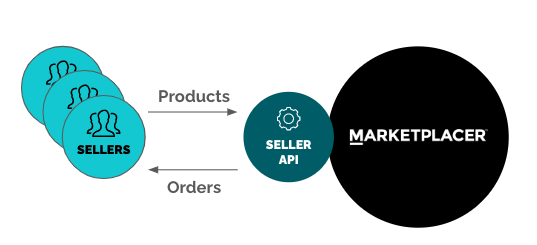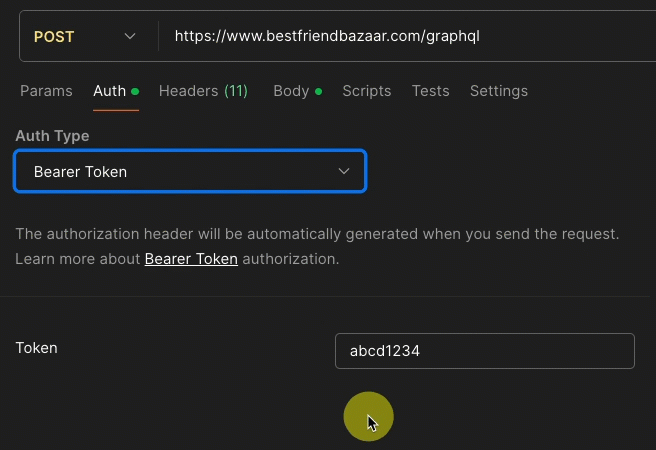Overview
5 minute read
What is the Seller API
The Marketplacer Seller API can be used by sellers to automate the processes required for selling their products on a Marketplacer marketplace:

The range of operations that you can perform with this API include but are not limited to the following domains:
- Product (aka Adverts)
- Orders
- Shipping
- Refunds
Language
A great way to familiarize yourself with the different terms and concepts used by Marketplacer would be to quickly review our Glossary of Terms.What is the Legacy Seller API?
The Legacy Seller API was the previous way Sellers could integrate into Marketplacer. The Legacy Seller API is a REST based API, whereas the current Seller API (i.e. the one you’re reading about now!) is a GraphQL based API.
IMPORTANT
Sellers building integrations into Marketplacer should only use the current GraphQL-based Seller API, and not the legacy REST based API.
All future developments, including new features will be added to the the GraphQL-based Seller API only
A Feature Matrix comparing the 2 Seller APIs can be found here.
GraphQL
This API complies with the graphql specification. If you’ve not worked with GraphQL before, then we strongly recommend taking a look at these docs as they give you a good grounding on the general concepts you’ll need if you want to get the most out of working with the API.
This video also gives a brief introduction to general GraphQL concepts:
Additionally, while you work with our GraphQL API, you may also find the following resources useful, both of which are auto generated from the Marketplacer GraphQL schema, and are therefore fully up to date:
- Full Documentation
- GraphQL Voyager An interactive visualization of our schema
Relay Specification
In addition to implementing the GraphQL specification, this API also follows the Relay Specification. This is a set of guidelines and conventions developed by Facebook for building GraphQL APIs in a consistent and efficient way.
It provides an opinionated view on things such as:
- The structure of GraphQL queries & mutations
- Interfaces for object types
- Pagination & Caching
Page Sizes
Paging result sets should be employed as a matter of best practice irrespective of the expected result set size.
A maximum page size of 500 is recommended for all GraphQL APIs.
This article explains how to use pagination with GraphQL queries.
Maximum Query Depth
We limit maximum query depth to 30.
Query depth refers to the number of nested levels within a GraphQL query. It measures how many layers deep a query goes when fetching related data. Excessively nested queries can cause performance issues when executing leading to increased execution times and reduced availability for all users of our GraphQL api.
To reduce the potential for deeply nested queries to cause problems, we limit maximum query depth to 30. This limit is evaluated prior to query execution and halts execution of any queries that exceed the limit. If your query exceeds the limit, you will receive an error response similar to the following:
{
"errors": [
{
"message": "Query has depth of 31, which exceeds max depth of 30"
}
]
}
API Collections
We have provided API collections for both Postman and Insomnia to get you started, please visit the Seller API Collections page to download and get started.
HTML Sanitization
We do not currently perform any type of HTML sanitization on object fields that could contain HTML or Script fragments. It is the responsibility of the consuming endpoint to perform such checks.
Content Type
API clients must supply a Content-Type header of application/json when sending request data:

Authentication
To authenticate to the API, use an Authorization header to pass your API Key:

If your Marketplacer instance is password protected via Basic Authentication, you will not be able to supply an API key and a username/password using an Authorization header.
In this case, set the username/password using the Authorization header (select the Basic Authentication scheme) and set the API key using the MARKETPLACER-API-KEY header:

Information on how to get your API key can be found in Getting Started
API Key Rotation
For more information on our API Key Rotation recommendations, please refer to this playbook.
Rate Limiting
We reserve the right to rate limit requests when call volume or load are too high. Rate limits may be expressed via the following HTTP response codes:
- 429 Too Many Requests response
- 503 Service Unavailable response.
These responses may contain a retry-after header which can be a number of seconds or a date.
If no retry-after header is provided then the default retry after value is 60s.
Retrying Requests
There may be occasions where you will need to retry the API request you made to Marketplacer as the original attempt may have failed. The reason an API call may fail will fall into 1 of 2 general error classes:
- Transient error conditions are those scenarios where retrying the same request again at a later point in time would likely result in a successful outcome. Examples of this type of error would be:
- Temporary network unavailability
- Rate limits have been hit
- Some other reason related to platform availability
- Non-transient error conditions are those scenarios where retrying the same request again at a later point in time would continue to result in an unsuccessful outcome. Examples of this type of error are:
- Malformed payload body
- Incorrect authentication credentials
Transient Vs Non-transient errors
Calls that fail due to non-transient errors are generally considered harder to retry, as you would usually need to change something about the original call in order for it to succeed.
With calls that fail for transient reasons, you just need retry that same call at a future point in time. An example of this type of retry is discussed below.
Retry Headers
One example of a transient error class that you may encounter when making API calls is to receive a HTTP 503 error response. This response will be accompanied by a rety-after header, an example of which is shown below:
retry-after: 30
The value of this header is the minimum time in seconds that you should wait before attempting to make another (retry) request.